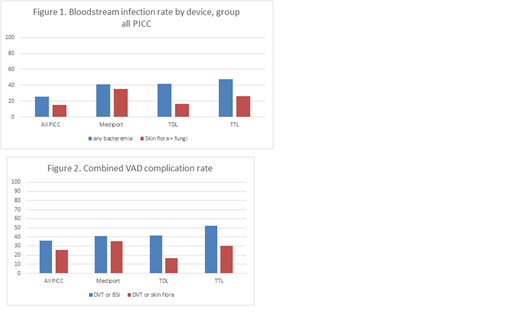Abstract
Introduction: Induction chemotherapy for acute myeloid leukemia (AML) is fraught with complications ranging from minor to life threatening. Central venous access is routinely achieved to administer cytotoxic chemotherapy to avoid damage to peripheral veins. Vascular access devices (VAD), however, are not without complications, ranging from bloodstream infection (BSI) to thrombosis. There is limited data on the safety of VAD, some showing equivalent risk for DVT across devices. In non AML patients, data has shown that risk of complications increase with the number of lumens within the device. We performed a single institutional analysis to investigate the correlation between VAD and infectious and/or thrombotic complications during induction chemotherapy for AML.
Method: We retrospectively reviewed medical records of 93 adults [median age 64 (21-89)] with AML at Beaumont Hospital, an academic community center from January 2010 - December 2015. We extracted data regarding type of VAD, thrombosis, and bloodstream infections during the first 60 days of induction chemotherapy.
Results: Demographic distribution of the cohort were 52 (56%) white, 4 (4%) African American, 11 (12%) others. Of these patients, 17 (18%) had single lumen mediport, 41 (44%) had peripherally inserted central catheter (PICC), 12 (13%) had tunneled dual lumen catheter (TDL), 23 (25%) had tunneled triple lumen catheter (TDL). Of the patients with PICC, 2 were single lumen, 1 was triple lumen. In the total population, 33 (35%) developed BSI with the following rates per VAD; Mediport 7 (41.8%), PICC 6 (25.6%), TDL 5 (41.7%), TTL 11 (47.8%). Bloodstream infection rate adjusted for skin flora and fungi were as follows; Mediport 6 (35%), PICC 6 (15%), TDL 2 (17%), TTL 6 (23%). Median time to BSI was 11 days (range 5-60) with no difference between type of VAD. Deep vein thrombosis of the upper extremity occurred in 5 of 93 cases, 4 of which were in patients with PICC and 1 with a TDL. Combined BSI and/or upper extremity thrombosis rate were as follows; Mediport 7 (41%), PICC 14 (36%), TDL 5 (42%), TTL 12 (52%). When adjusted for BSI due to skin flora combined with DVT the rates were Mediport 6 (35%), PICC 10 (25.6%), TDL 2 (17%), TTL 7 (30%).
Conclusion: In patients undergoing induction chemotherapy for AML, the choice of VAD was associated with different levels of risk of BSI and DVT. The lowest overall BSI rate was with PICC. When adjusted for BSI due to skin flora or fungi, PICC and TDL were similar. The combined risk of BSI and DVT was lowest with PICC, however, if only accounting for BSI due to skin flora or fungi, then TDL was the safest. A lower rate of line associated DVT risk may be achieved with a tunneled VAD compared to PICC. This data suggests that dual lumen PICC or TDL are the optimal VAD for induction chemotherapy in AML patients.
Figure 1. Skin flora include S. epidermidis, Acinetobacter, S. aureus, S. viridans.Fungi includeCandida species, R. mucilaginosa.
No relevant conflicts of interest to declare.
Author notes
Asterisk with author names denotes non-ASH members.


This feature is available to Subscribers Only
Sign In or Create an Account Close Modal